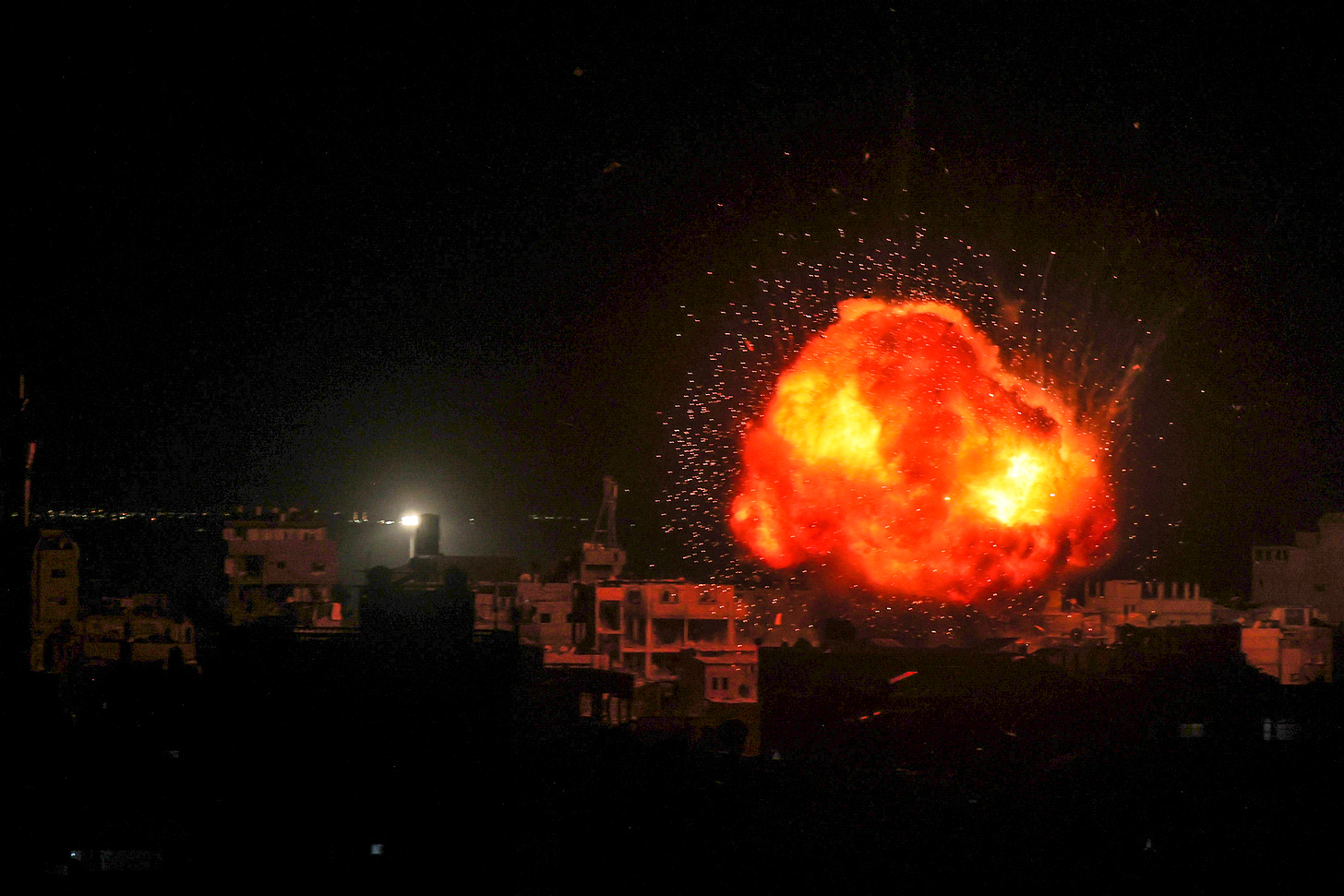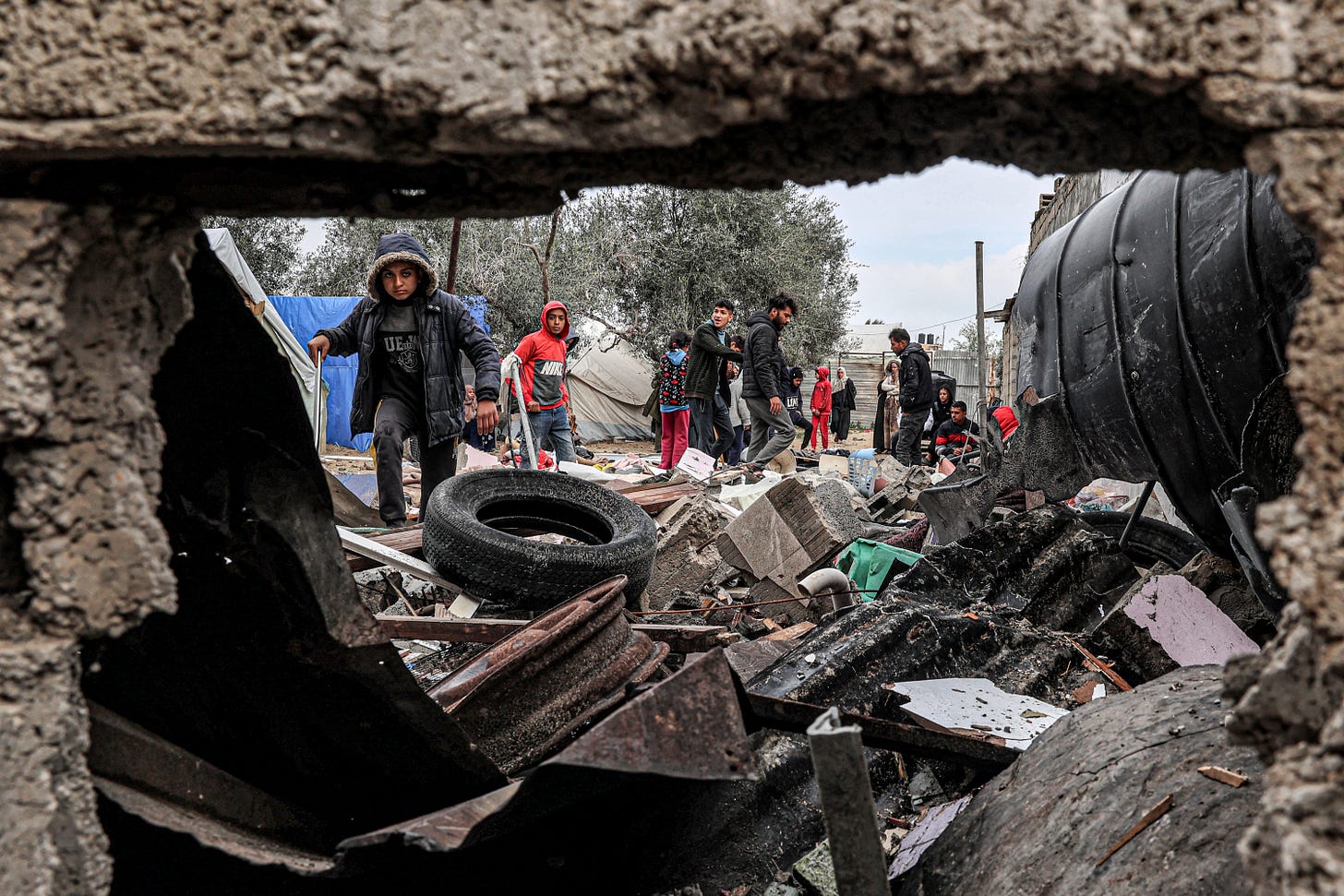What to Expect from an Israeli Offensive in Rafah
And where the overall war in Gaza now stands.

THE ISRAEL DEFENSE FORCES (IDF) are expected soon—in the next few days or weeks—to attack Rafah, the southernmost major city in the Gaza Strip and the last one the IDF has yet to clear of Hamas. The war in Gaza has been atrocious and costly in time and lives for both sides. The Biden administration has shifted from asking (warning?) Israel not to enter Rafah to quietly counseling Israel on how to do it as humanely as possible.
As the war enters what may be its bloodiest, hardest, and most politically fraught phase, it’s worth analyzing how it reached this point, what’s at stake, and what is likely to happen in the future.
The Israeli government believes Hamas represents an existential threat, and the Israeli people apparently agree. Israel exists to provide Jews a place to live in peace, and with the October 7 attacks, a foreign threat called into question for the first time since 1973 its ability to do so. Hamas isn’t in some far-off region like Afghanistan or Iraq. It is right next door, as close to some Israeli towns as Juárez is to El Paso or Windsor to Detroit.
Because of the proximity of the threat, Israel has set out on a total war to destroy Hamas’s offensive capabilities and end its rule in Gaza. Some experts have argued for a counterterrorism or counterinsurgency approach instead. These are unrealistic strategies. It’s hard to fathom how the Israeli intelligence community that just missed the most significant attack in Israeli history would be able to pivot to counterterror operations against an enemy hiding underground, or why the people of Israel would trust it to do so. Further, a counterterrorism operation would not have destroyed Hamas’s military infrastructure. It would have just lopped off a few heads—which is exactly what the Israeli military did to Hamas for sixteen years before the October 7 massacre. More of the same would not lead to Hamas relinquishing control of Gaza.
As for counterinsurgency, the sort of population-centric counterinsurgency model used by the United States and our allies in Iraq and less effectively in Afghanistan is bound to fail for lack of a legitimate government in Gaza. It’s unlikely any Hamas replacement would curry favor by allying with Israel. More importantly, Hamas has yet to be defeated. A counterinsurgency model might work in a future, post-Hamas Gaza if an insurgency were to erupt against the eventual ruler (which is almost inevitable). But not now.
Netanyahu’s ground invasion was the only viable option for achieving his stated war objectives. That doesn’t mean it has been executed well in every particular and it doesn’t mean there haven’t been casualties and costs that could have been avoided. As much as we wish we could make war immaculate, it will always be a human endeavor. And Netanyahu’s decision to use overwhelming force in a bloody urban war is broadly popular in Israel, as the Israeli public believes it is the best way to achieve the desired end state.
AFTER SIX MONTHS of grinding operations, the IDF has made progress. They report having killed between 11,500 and 13,000 Hamas fighters and effectively “dismantled” (but not entirely destroyed) twenty of the group’s twenty-four battalions. Many of the remaining Hamas fighters reportedly went to Rafah, which is why the IDF is set on clearing the city.
Israel is also degrading Hamas’s command and control. They recently killed Marwan Issa, Hamas’s third in command, and reportedly nearly got Hamas leader Yahya Sinwar, who is hiding behind hostages. The IDF recently killed or captured almost a thousand Hamas and Palestinian Jihad fighters during an operation at Al Shifa Hospital. Senior Hamas leaders are reportedly among those captured.
While the IDF’s operations have been militarily successful, they are not without controversy, primarily due to the high number of “civilian casualties”—a term that sterilizes a human tragedy. Tens of thousands of innocent Gazans have been tragically killed, and hundreds of thousands of Gazans are trying to survive in a hellish landscape.

All war is brutal, but urban warfare can be especially savage because terrorists often stage attacks intentionally to maximize the number of dead women, children, and elderly. I’ve seen this firsthand: Al Qaeda in Iraq often placed multiple IEDs at an attack site so they could first kill Americans, the Iraqi Army or Police, or civilians—and then the first responders, too.
However, the IDF is taking extraordinary measures to protect civilians. According to John W. Spencer, chair of urban warfare studies at the Modern War Institute at West Point, “Israel has taken more measures to avoid needless civilian harm than virtually any other nation that’s fought an urban war.” The U.S. military did not use as extensive caution in Iraq and Afghanistan—we usually just dropped leaflets or used government-friendly radio stations to inform the population of impending danger. We never telegraphed our punches like the IDF, which is alerting Gazans to the locations of future operations neighborhood by neighborhood, including with text messages.
Hamas’s own casualty reports must be treated with skepticism. Their latest figure from this week is 32,552 Gazans dead since the beginning of the conflict. But the Hamas statistics don’t distinguish between civilians and fighters. And they mathematically just don’t make sense: Hamas has claimed that 70 percent of the dead are women and children, but also that at least 6,000 of its fighters have been killed. The only way for both those claims to be true, writes Wharton statistician and data scientist Abraham Wyner, would be if “Israel is somehow not killing noncombatant men, or else Hamas is claiming that almost all the men in Gaza are Hamas fighters.”
Still, Wyner’s analysis suggests that—assuming Israel’s figure for the number of Hamas fighters killed is accurate—“the ratio of noncombatant casualties to combatants is remarkably low: at most 1.4 to 1 and perhaps as low as 1 to 1.” By the historical standards of urban warfare, that would be an outstanding achievement.
In short, the IDF’s campaign is making steady progress toward its goal of destroying Hamas. That progress is slow, primarily because of how sophisticated and extensive Hamas’s tunnel network is. The tunnels are what differentiate Hamas from the other terrorist groups we’ve fought over the past twenty years. (According to Spencer, the only parallel is the Battle of Manila late in World War II, in which it took 35,000 Americans over a month to defeat 17,000 Japanese who made use of the city’s tunnels; some 100,000 civilians were killed.)
The Israelis are learning as they go. There is no doctrine for fighting in such an extensive network of tunnels. It is a painstaking, cumbersome process that will likely continue for months, even after a future Rafah operation.
Israeli operations are further slowed by the apparent continued presence of hostages—including six Americans—in those tunnels. While the destruction of Hamas takes precedence, hostages are a particularly sensitive political issue in Israel. The Israelis must try to retrieve those who are still alive, and the remains of those who have been killed, if possible. But doing so prolongs the conflict, resulting in more civilians and IDF soldiers being killed.
PRESIDENT JOE BIDEN’S SUPPORT for Israel is not popular among the younger, more progressive members of his party. In what is likely to be a close election, he will need a broad coalition, including Muslims and Jews, to defeat former President Donald Trump.
Biden’s political problems partly explain his increasingly fraught relationship with Netanyahu—although it is hard to tell how much of the rift is real and how much is for show. While it might be beneficial in terms of domestic American politics for Biden to lambaste Bibi, doing so would likely only strengthen Netanyahu’s right-wing coalition.
Nevertheless, neither politician benefits from a full-blown rupture of relations. Biden would be exposed to further attacks from Republicans that he’s a weak, untrustworthy leader who abandons allies on the battlefield, as in Afghanistan. For Netanyahu, he would be not only responsible for having failed to prevent the worst attack on Israeli soil but also for the harm to Israel’s relations with its most important ally.
Certainly Biden will find it nearly impossible to keep Netanyahu from entering Rafah. Netanyahu wouldn’t survive politically if he didn’t go in. Israelis are the only ones who can prevent Netanyahu from entering Rafah—and they want him to go in.
So the IDF is going in to Rafah. There seems to be no stopping it. The images will be heartbreaking. Thousands of women, children, and elderly will likely be killed. Hopefully, following a successful operation in Rafah, there will be a temporary ceasefire as the IDF transitions to less intense operations.
But as so often in war, your best bet is that things will get worse before they get better.





